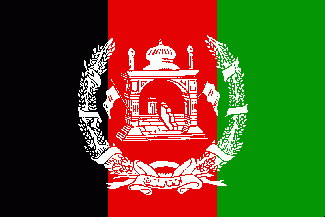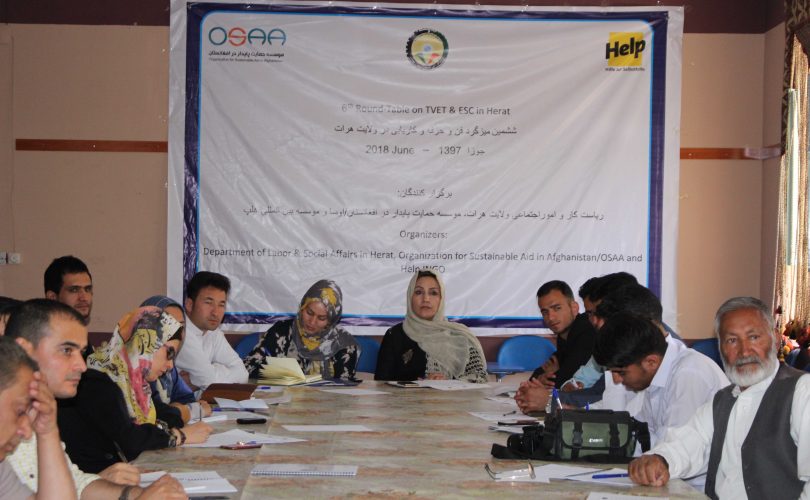Tuesday, June 05, 2018
6th TVET & Employment Round Table was organized by OSAA and Help INGO in coordination with Herat DoLSA in Women Economic and Services Cooperative hall on 05.June.2018.
The heads and representatives of Herat DoLSA, National Union of Craftsmen, Agriculture Institute of Herat, Herat Council of Experts, Women Economic and Services Cooperative, Economics Faculty of Herat University, NSDP Employment Services Center, WFP, Help, OSAA, CRDSA, PIN, GP, AVI, DRC, HPS I/NGOs, CSOs and a number of Herat University students participated in this Round Table.
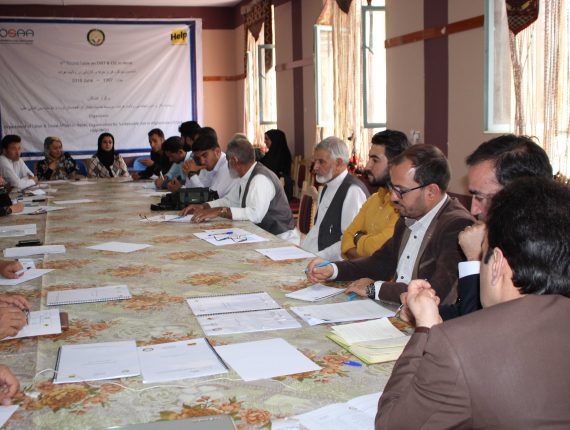
The agenda of 6th TVET & Employment Round Table included “reporting on how to conduct annual researches on marketable vocations, the results of these researches and collecting ideas and recommendations to carry out this year’s research well and more comprehensive.”
Over the past two years, in order to identify marketable vocations and vocations with potential to grow and to improve the process of provision of TVET and employment services in VTCs, Help INGO and OSAA, in cooperation with Herat DoLSA conducted two annual researches in Herat province. The two mentioned organizations along with Herat DoLSA and other I/NGOs providing TVET used these researches and their results to run their TVET programs according to the market demands.
At the beginning, Mr. Masoud Amini, OSAA project officer, welcomed all participants to this Round Table and had a review on the goals and results of previous Round Table. He said that we had discussions to collect ideas, suggestions and recommendations of organizations and different sectors including government and private sectors, CSOs and the representatives of guilds and unions in Herat province to be presented to the National Labor Conference in Kabul. Opinions and suggestions were collected on how to create jobs in different sectors and the role of the government in preparing an appropriate framework, creating jobs, developing human capital, increasing women’s participation in the sectors, creating special economic zones, employment for returnees and IDPs, creating jobs in the agriculture sector, rural development, industry and commerce, mining, construction and transport sectors.
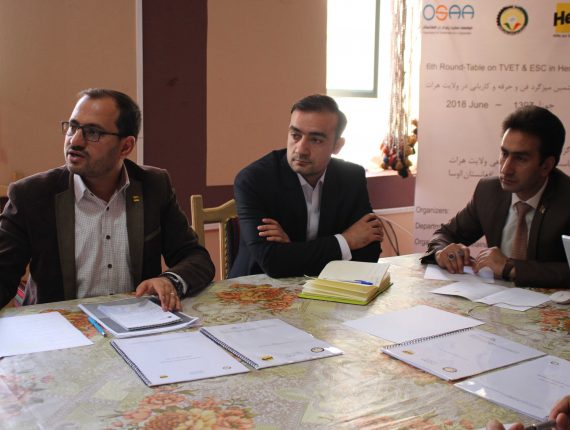
Then, Mr. Zabihullah Monib Taheri, Help Country Director in Afghanistan, who was invited to the National Labor Conference in Kabul from west zone, talked on his participation and the topics discussed in this conference to the audiences. He said, “This conference was held from 29.April to 01.May.2018 in Kabul and was an opportunity for the government to present its activities and focus on facilitating employment and setting out job creation strategy in Afghanistan.”
He added, “On the first day, we visited the exhibition of domestic products and employment that was held by the Ministry of Labor and Social Affairs, Martyrs and Disabled in Kabul Babur Garden.”
The second and third day of the conference was opened by His Excellency Dr. Abdullah Abdullah, the CEO of GoIRA in the presidential palace. The organizers of this conference were MoLSA and Presidential Economic Senior Advisory.
Mr. Taheri mentioned three main objectives of “National Labor Conference” as follows:
1- Identify and propose applicable policies at the micro and macro-economic levels that lead to employment, increased incomes of Afghan families and poverty reduction;
2- Promote and encourage labor-intensive projects to increase job opportunities;
3- Promote and encourage working partnerships that are responsive and be a solution to the development of human resources and meet market demand;
He also talked about the structure of 9 panels in this conference and the topics raised in each of these panels. He added that the purpose of creating these panels was to identify the long-term plans of the government in various sectors.
Panel I: Macroeconomic priority strategies, measures to create jobs;
Panel II: Regional economic cooperation and job creation;
Panel III: Human capital development and job creation;
Panel IV: Increasing the level of women participation in the workforce market;
Panel V: Different perspectives on jobs (employment for IDPs and returnees) increasing social partnership in special economic zones and employment;
Panel VI: Creating jobs in the agriculture and rural development sectors;
Panel VII: Creating jobs in industries and commerce (increasing the contribution of private sector in job creation);
Panel VIII: Mining and construction (growth and employment);
Panel IX: Transportation sector and job creation.
At this conference, 28 MoUs were signed between the Ministry of Labor and other ministries and directorates in Kabul.
At the end, Mr. Monib (Taheri) concluded his speech by providing figures on unemployment rate raised in this conference: among the 34 million population in Afghanistan, 15 million are eligible to work out of that 8.5 million are working. 24% or 2 million are unemployed that number reaches to 34% in the winter.
Also, in the next four years in Afghanistan, 3.5 more million people will be added to the eligible workforce. According to the Ministry of Labor research, an average of 140,000AFN is required for a person to set up his/her private and small business and the state authorities emphasized on commitment to create work and facilitating job opportunities.

Then, Mr. Sayed Ab. Tawab Hossaini, OSAA Employment Services Center manager, explained a summary of the researches that were conducted over the past two years as following:
These researches on Marketable Vocations were conducted by OSAA and Help INGO in cooperation and partnership with Herat DoLSA and the Faculty of Economics of Herat University in 2016 and 2017.
Objective of 2016 Research:
The research aimed at collecting reliable information and related data on marketable vocations in Herat province. The main focus is to understand the level of saturation of vocations as compared with Herat population, in order to identify the level of demand for offering new vocations in Vocational Training Centers.
In total, 350 individuals were assessed through questionnaires and interviews.
Research Findings:
At the end of this research, we could divide the available vocations in Herat market into the following categories:
- Marketable vocations;
- Semi-marketable vocations;
- Vocations with potential for growth;
- Saturated vocations.
Conclusion:
This research covers 36 out of 66 available vocations in Herat market. The findings of the research show that 10 vocations (27.7%) scored between 78.2-93%. These vocations are top in terms of marketability due to the actual lack of expert individuals, higher demand for products than their supply and increasing number of consumers. It can be concluded that more graduates of these vocations (with an average success rate of 89.12%) will be absorbed in the labor market easily.
On the other hand, 10 vocations (27.7%) scored between 54-75%, and due to relative equality of demand and supply are graded in the second rank in terms of marketability as semi-marketable vocations. There seems to be no need to train more individuals in these vocations.
In the third group there are the vocations with potential for growth in Herat market. 5 vocations (13.85%) scored between 50-56%. This means that these vocations have not been fully integrated in Herat market yet and there is little need for these vocations. However, these vocations might in the future be placed among the vocations with medium and high demand.
Objective of 2017 Research:
The research aimed at collecting reliable information and related data on marketable vocations in Herat city and the surrounding districts of the city (Karukh, Enjil, Guzara and Zendejan). The main focus of the research was to understand the saturation level of vocations considering the population of the city and the surrounding districts in order to identify the demand for new vocations in vocational training centers and mobile VTCs.
Findings of the Research at Herat City Level
By conducting this research we could divide the available studied vocations of Herat market into the following categories:
Findings of the Research at Districts Level
It is worth mentioning that the findings of the research in the four districts were obtained generally.
The Research Recommendations:
- Support and solve beneficiaries problems after graduation;
- Select motivated and eligible beneficiaries;
- Non-selection of school and university students for vocational classes;
- Perform regular researches annually.
Finally, he added that by using of these researches the result of TVET programs will be useful and effective.
Then, Mr. Ezmerai Danesh, lecturer at Faculty of Economic, Herat University, who will be the technical advisor to the research team of 2018, talked about how to conduct the new research, its goals and how to analyze marketable vocations. He said, “Today, in Afghanistan, most of the works and projects that are implemented do not take place considering researches and the unfamiliarity of the market can lead to unsuccessful work. If any of the first steps are based on a research, the project can be succeeded.”
He added, “We witness that the jobseekers do not enjoy the required skills of the market and with conducting such researches the market demand is identified and TVET programs will be offered based on market needs. The workforce should get informed about the new market demanded vocations and we better plan for new vocations and the needs of the market.” Mr. Danesh added that there are vocations which reached saturation level and they do not need any more investment and training. In our research this year, our effort will be to take all aspects of the implementation of a standardized research into account to prepare a comprehensive research.
Opinions and suggestions of participants to have a complete research in 2018:
- The upcoming research ought to be more completed, content-rich and covers a wider statistical society at the city and districts levels;
- Identify the needs of the national projects in the future and design TVET programs in accordance with the needs of these projects;
- Increase focus on technology sectors that causes increasing job creation and results in economic growth in the country;
- Special attention to the agriculture industry since 60% of all Afghans are working in this sector;
- This year’s research should cover more districts because villagers have a lot of problems with food storage and processing and they really need professional and vocational training;
- Offer practical and functional TVET programs in accordance with the market demand;
- Awareness on conducting annual researches in order to make a synergy among partners and find constructive comments and suggestions on conducting the research;
- Attention to home-businesses for the growth and dynamics of homemade products;
- Synergy among government departments, partner agencies and other stakeholders in conducting this year’s research;
- Include the topic on how to substitute skilled foreign labors with trained and skilled Afghan labors;
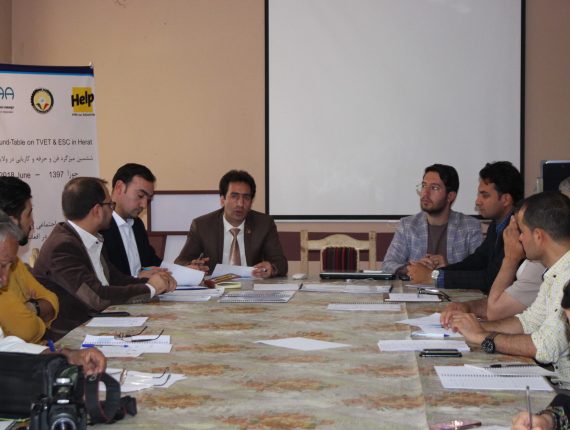
At the end, Mr. Ab. Qayoum Afghan, Head of Herat DoLSA, concluded the topics discussed in this meeting. He said that participants’ comments and suggestions will be useful and effective for the new research. He also added, “Implementing a project based on a research and survey will have appropriate results. Mr. Afghan while noted his department’s support to this year research, invited all I/NGOs, government departments, universities and CSOs to cooperate in conducting this year’s research to foster the results of the research.
He continued that they will try to organize programs so that more people learn skills and find jobs. If the quality of work increases and produces good products, this will cause job creation. He asked each of the participants to pay particular attention to the problems of lack of job creation, poverty and unemployment and have multilateral cooperation in implementation of DoLSA programs.
Finally, he added that we should not be disappointed of implementation of development projects in the long term due to insecurity and war and mentioned that job creation can solve many of the problems in Afghanistan.
Source: Help Media And Culture Department
